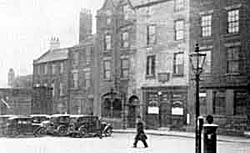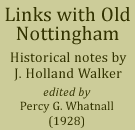< Previous | Contents | Next >
Weekday Cross
 |
WEEKDAY CROSS was the market-place of Nottingham in days before the Norman Conquest.
In those far-oft times Nottingham, or as it was then called, "Snotingaham," was a small but important place defended by fortifications and clustering round the top of St. Mary’s Hill.
It had its own church which stood where St. Mary’s is now erected, its own Moot Hall, or public hall, which stood on a site on the south-east of Weekday Cross (which disappeared when the course of the L. and N.E. Railway was altered, about 1900), and on Weekday Cross our Saxon forefathers met to do their marketing.
When the Normans came, a new Nottingham sprang up around Peveril’s Castle. This was called the French Borough, just as the ancient town was called the English Borough, and although together they formed the Norman Nottingham each was ruled by its own officers and laws.
For a variety of reasons it was found inconvenient for the inhabitants of the French Borough to market at Weekday Cross, and so a new market, which was held on Saturdays, was established in what is now the Old Market Square. Gradually this Saturday market became of great importance and attracted the countryside, but Weekday Cross remained the centre of the domestic trade of Nottingham for many years after the Conquest.
When the actual Weekday Cross was set up is unknown, but it must have been a long while ago, for the erection of a cross in a market-place is a very ancient custom. The Cross was altered and repaired all through Nottingham’s history, and its position was in the north-west of the little area, and the first actual mention of it is in 1549. It appears (as also does the Malt Cross) on the map, dated 1610, which will be found in this volume. The Cross was pulled down in 1804.
Weekday Cross, or Weekday Market, as it was then called, was the civic centre of mediaeval Nottingham, and as such had its bull ring which is mentioned in 1541. It was situated at the end of Fletcher Gate, which was the butchers’ quarter in those days, and it remained there till 1691.
The site of the ancient market well, which was fitted with a pump in 1636, is marked by the pillar-box.
